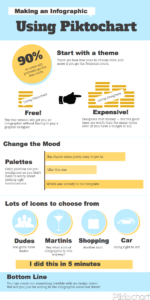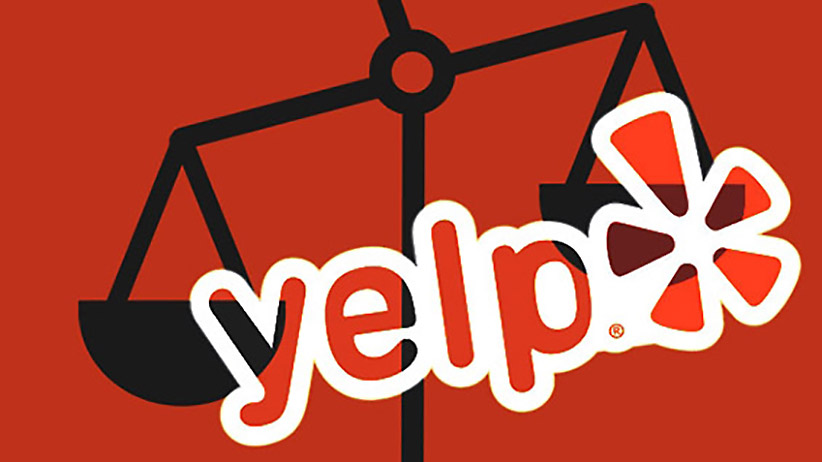
Yelp is a virtual marketplace that has been shaping our spatial orientation for many years, since it was founded in 2004 and has increasingly expanded worldwide since 2009. Despite its vast impact on our daily life, its digital rhetoric has hardly been researched and is usually taken for granted without further critical awareness. In a 2013 survey, the Boston Consulting Group found that only 15% of 4,800 interviewed small business knew that they had a free Yelp profile and that only 11% had claimed it. And despite the significant increase of profits by advertising or just being listed on Yelp, most small businesses do not partake in this new digital marketplace. Still, Yelp’s digital reality is no neutral “Archimedean” point of reference. Rather, it modifies and manipulates the reality we perceive through it. In this respect, this lesson plan seeks to raise a more critical awareness of the digital rhetoric of Yelp. The digital skill required for making an infographic with Piktochart fits to Unit 3 (weeks 13-15) of the RHE 306 Instructor Guide.
Learning Objectives
This lesson plan seeks to increase student’s critical awareness engaging with Yelp. Students not only learn to question the ranking and categorization procedures by Yelp, but also acquire oral skills in presenting their findings, digital skills in developing an Infographic (or a Powerpoint) presentation, and writing skills in composing an argumentative essay.
The students will learn:
- to engage critically with Yelp’s digital rhetoric
- to discuss and present orally their findings and opinions
- to develop an Infographic (or a Powerpoint) for their presentation
- to compose an argumentative essay
Assignment Length
2 class meetings (75 min classes
Required Materials
Yelp on Mobile Devices; Piktochart (alternatively Powerpoint); Projector
Access and Adaptability
This lesson is ideally conducted in a digital classroom, where Infographics (or Powerpoints) are easily projected to the whole class. But as long as a projector is available, any other classroom may be used as well.
Assignment Description
This lesson plan is ideally conducted in 2 (75 min) class meetings. But individual elements may be cut or modified. For the students’ presentations, either Piktochart or Powerpoint can be used. This Inc magazine article by Max Chafkin is the reading for the students as homework for the second lesson and serves as a great introduction to Yelp.
Instructor Preparation
- Make yourself familiar with Yelp, especially with class reading
- Skills using Piktochart or Powerpoint
- Prepare for Projector Presentation
Student Preparation
Ideally, students have already acquired digital skills with Piktochart (or Powerpoint); if not teacher should spend more time for instructions and questions
Students bring their mobile devices with Yelp app installed.
In-Class or Assignment Instructions
LESSON 1:
1. Initial Conversation about Yelp: Who has used Yelp before? What have you used it for? How does Yelp influence our perceptions of reality? Where could there be possible problems or manipulations? (Teacher Student discussion; minutes 0-10)
2. Students use Yelp on their mobile devices and compare the “popular categories” in different spaces (Austin vs. students’ home towns vs. an extremely rural place [e.g. Barrow [AK]]): How do they differ? What do they tell us about these places? Also: what do the categories imply about a “normal life”? Teacher may collect answers on board. (first individual students on their mobile devices, then teacher student discussion; minutes 10-25)
3. Yelp used from “current location” in (UT Austin) classroom in groups (6 groups, 3-4 students per group). Each group focuses on one “popular category” from “current location” from the six categories (1. “Delivery,” 2. “Restaurants,” 3. “Coffee & Tea,” 4. “Gas & Service Stations,” 5. “Drugstores,” and 6. “Shopping”). Task: student analyze the lists (1.-20.) in each category with regards to the deciding factors for its ranking, when no filter is used (proximity, costs, star rating, review’s quantity and quality [who reviews, e.g. Yelp’s Elite Squad?]. (group work; minutes 25-50)
4. Groups present their findings to the class orally; teacher may collect findings on the board. (groups presentations, minutes 50-70)
5. Homework: read article by Inc magazine and prepare in groups an Infographic (or Powerpoint) with groups’ findings concerning the scenario: “Give a presentation to a future investor who wants to open a new business in your category. How does the new business appear most likely on the top of the list in your category?” (each presentation 5min)
LESSON 2:
1. Students present their infographics (or Powerpoints) to the class as “future investors.” (minutes 0-35)
2. Students take a step back and reflect critically about their findings and the text: Who is benefitting from Yelp the most vs. the least? What are problems with Yelp? How could Yelp or how can businesses manipulate the rankings? (Think, Pair, Share; minutes 35-55)
3. Students prepare for writing an argumentative essay (1000 words) about the advantages and disadvantages of Yelp, by taking a position for or against Yelp and dealing with “counter-arguments.” (individual work; minutes 55-75; submitted for homework)
4. Homework: finish argumentative essay and submit for a grade

Skills Workshop
This lesson is ideally combined with a Piktochart skills workshop conducted by a DWRL staff member. Here is a link to Beck Wise’s infographic about how to make an infographic. And here are some examples the teacher can use as exmples for the students, e.g. a cat’s body language, about how much cats actually kill, and about the healing powers of cat purrs.
Assessment Suggestions
The Infographic can be graded according RHE 306 grading standards (RHE 306 Instructor Guide, weeks 13-14). The argumentative paper can equally be graded by the rubrics in the RHE 306 Instructor Guide Unit 3, weeks 11-12; grading rubrics: pg. 134-137).
The infographic and argumentative paper may be graded as a portfolio. The infographic presentations may incorporate peer feedback by the other students. Both, the infographic’s form and content are to be graded. How does the form contribute to the content and vice versa.[/x_tab][x_tab active=”false”]For the argumentative paper, the traditional standards for grading RHE 306 papers can be used. Papers should follow a clear argumentative structure, with a clear thesis, multiple arguments, concrete examples as well as a conclusion.





